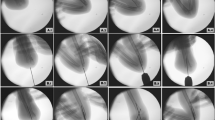Abstract
The purpose of this study was to compare primarily open versus primarily closed surgical treatment of Gartland type III extension supracondylar fractures in children. Also the outcomes of different pinning techniques in open surgery were evaluated retrospectively. Eighty displaced type III extension supracondylar fractures treated consecutively at two different centres were included. The treatment protocol of one institute was primarily closed reduction and percutaneous cross-pinning (n = 43). The treatment protocol of the other institute was primarily open reduction and internal fixation (n = 37) with two lateral parallel pins (n = 11), cross pins (n = 11) and two lateral and one medial pin (n = 15) according to the stability and configuration of the fracture. According to Flynn’s criteria the outcomes of the open and closed reduction groups were not statistically significant (P > 0.05). Although the outcomes of closed reduction showed no superiority over open reduction, it should be the first choice of treatment due to its low morbidity and short hospital stay.
Résumé
Le but de cette étude est de comparer le traitement par réduction orthopédique ou réduction sanglante des fractures supracondyliennes type III de Gartland en extension chez l'enfant. Par ailleurs, l'évolution des différentes techniques d'embrochage à foyers ouverts ont également été évaluées de façon rétrospective. Matériel et méthode: 80 fractures en extension de type III supracondyliennes ont été traitées de façon consécutives dans deux centres différents. Le protocole du traitement dans un des centres était la réduction à foyer fermé avec brochage percutané (n = 43) et dans l'autre établissement, à foyer ouvert avec fixation interne (n = 37), deux broches parallèles (n = 11), deux broches en croix (n = 11), deux broches externes et une interne (n = 15), ceci en fonction de la stabilité et de l'aspect de la fracture. Résultats: selon les critères de Flynn, il n'y a pas de différence de résultats entre les traitements à foyer fermé ou après réduction sanglante (p > 0,05). En conclusion: l'évolution des fractures traitées à foyers fermés n'est pas meilleure que celles traitées à foyers ouverts les conditions du choix doivent être la diminution des complications et l'abaissement de la durée moyenne de séjour.

Similar content being viewed by others
References
Agus H, Kalanderer O, Kayalı C, Eryanılmaz G (2002) Skeletal traction and delayed percutaneous fixation of complicated supracondylar humerus fractures due to delayed or unsuccessful reductions and extensive swelling in children. J Pediatr Orthop B 11(2):150–154
Battagila TC, Armstrong DG, Schwend RM (2002) Factors affecting forearm compartment pressures in children with supracondylar fractures of the humerus. J Pediatr Orthop 22:431–439
Cramer KE, Devito DP, Green NE (1992) Comparison of closed reduction and percutaneous pinning versus open reduction and percutaneous pinning in displaced supracondylar fractures of the humerus in children. J Orthop Trauma 6:407–412
Flynn JC, Matthews JG, Benoit RL (1974) Blind pinning of displaced supracondylar fractures of the humerus in children. J Bone Joint Surg Am 56:263–272
Eidelman M, Hos N, Katzman A, Bialik V (2007) Prevention of ulnar nerve injury during fixation of supracondylar fractures in children by ‘flexion-extension cross-pinning’ technique. J Pediatr Orthop B 16(3):221–224
Gartland JJ (1959) Management of supracondylar fractures of the humerus in children. Surg Gynecol Obstet 109:145–154
Kalanderer O, Reisoglu A, Sürer L, Agus H (2007) How should one treat iatrogenic ulnar injury after closed reduction and percutaneous pinning of paediatric supracondylar humeral fractures. Injury 76:253–256
Kotwal PP, Mani GV, Dave PK (1989) Open reduction and internal fixation of displaced supracondylar fractures of the humerus. Int Surg 74:119–122
Larson L, Firoozbakhsh K, Passarelli R, Bosch P (2006) Biomechanical analysis of pinning techniques for pediatric supracondylar humerus fractures. J Pediatr Orthop 26(5):573–557
Lyons JP, Ashley E, Hoffer MM (1998) Ulnar nerve palsies after percutaneous cross-pinning of supracondylar fractures in children’s elbows. J Pediatr Orthop 18:43–45
Mulhall KJ, Abuzakuk T, Curtin W, O’Sullivan M (2000) Displaced supracondylar fractures of the humerus in children. Int Orthop 24(4):221–223
Oh CW, Park CB, Kim PT, Park IH, Kyung HS, Ihn CJ (2003) Completely displaced supracondylar humerus fractures in children: results of open reduction versus closed reduction. J Orthop Sci 8:137–141
Özkoc G, Gonc U, Kayaalp A, Teker K, Peker TT (2004) Displaced supracondylar humeral fractures in children: open reduction vs. closed reduction and pinning. Arch Orthop Trauma Surg 124:547–551
Rockwood CA Jr, Wilkins KE, Beaty JH (1996) Fractures in children, vol 3. Lippincott-Raven, Philadelphia
Sadiq MZ, Syed T, Travlos J (2007) Management of grade III supracondylar fracture of the humerus by straight-arm lateral traction. Int Orthop 31(2):155–158
Sankar WN, Hebela NM, Skaggs DL, Flynn JM (2007) Loss of pin fixation in displaced supracondylar humeral fractures in children: causes and prevention. J Bone Joint Surg Am 89(4):713–717
Skaggs DL, Cluck MW, Mostofi A, Flynn JY, Kay RM (2004) Lateral-entry pin fixation in the management of supracondylar fractures in children. J Bone Joint Surg Am 86-A:702–707
Skaggs DL, Hayle JM, Basset J, Kaminsky C, Kay RM, Tolo VT (2001) Operative treatment of supracondylar fractures of the humerus in children. The consequences of pin placement. J Bone Joint Surg Am 83-A(5):735–740
Skaggs DL, Kay RM, Tolo VT (2002) Fracture stability after pinning of displaced supracondylar distal humerus fractures in children. J Pediatr Orthop 22(5):697
Zionts LE, McKellop HA, Hathaway R (1994) Torsional strength of pin configurations used to fix supracondylar fractures of the humerus in children. J Bone Joint Surg Am 76:253–256
Author information
Authors and Affiliations
Corresponding author
Rights and permissions
About this article
Cite this article
Kazimoglu, C., Çetin, M., Şener, M. et al. Operative management of type III extension supracondylar fractures in children. International Orthopaedics (SICOT) 33, 1089–1094 (2009). https://doi.org/10.1007/s00264-008-0605-0
Received:
Revised:
Accepted:
Published:
Issue Date:
DOI: https://doi.org/10.1007/s00264-008-0605-0




